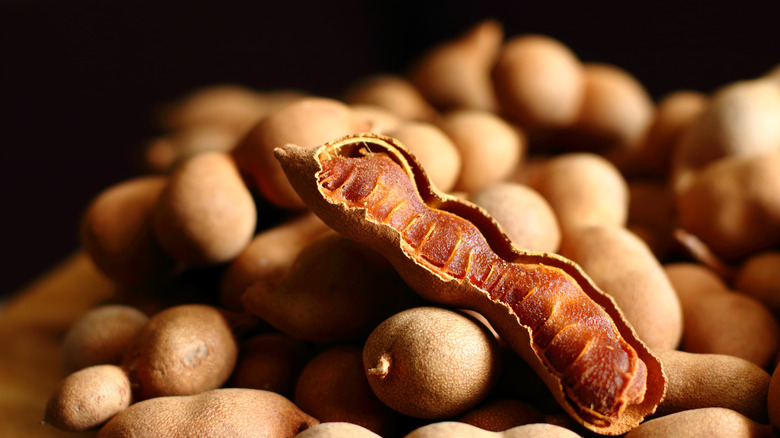Why You Should Be Eating More Tamarind
If you've never heard of tamarind, then just think of it like coconut oil in the early 2000s — AKA, one of the internet's best-kept secrets, thanks to its incredible lineup of benefits (both in food, and out). And, like coconut oil, we're willing to bet that tamarind also is going to fly off the shelves once that secret is out.
Tamarind is a "plump pod-like fruit with a sweet, tangy flavor that is indigenous to tropical Africa," reports Bon Appétit. The fruit's name even translates directly to "Indian date," which makes a whole lot of sense, considering the bright and flavorful food possesses a lot of the same qualities as a typical date.
Today, we're going to focus on the many reasons you should eat tamarind, but — like coconut oil — it's full of benefits that might just make their way into your daily life, too. The fruit comes in several different forms, ranging from unripened fruit to a thick paste or dehydrated powder, but it's not just versatile in its physical shape; it's versatile in how you can use it, too. The leaves of the fruit might make their way into an at-home DIY remedy, and the wood may be used in special carpentry projects, explains Bon Appétit. And yet, believe it or not, the real benefits lie in actually eating the little-known fruit itself. The flavor of tamarind changes greatly depending on the form that you use it in your cooking.
Tamarind helps balance out a dish with its unique flavor profile
But that's part of what makes it so great. If you lose it at the back of your produce drawer, it's not a lost cause — just change up your game plan and incorporate it into a recipe in a new way!
Tamarind has a "complex flavor profile," especially when it's concentrated. It's sweet but sour, citrus-y but peppered with notes of "smoke and caramel," especially pronounced in some of their suggested dishes, like Vietnamese Lemongrass Tamarind Chicken. Basically, it's everything you never knew you needed and more.
Tamarind is at its most tart when unripe, but it's highly acidic across the board. Of course, this means you're in for a pucker-faced first bite, but trust us: A little bit of tamarind goes a long way, especially if you're hoping to balance out the flavors in a sweet or salty dish. If you're looking for something a little more mild to add to a dish, you can grab a fresh block of the bold fruit at the supermarket, then make a marinade out of it that'll complement any protein and make your meat perfectly tender. Or, to make your own paste at home, you can soak the tamarind pulp in hot water and then squeeze the extract out. And if you're feeling particularly lazy (or maybe just intimidated by this new ingredient), you can find a pre-made chutney or powder at the store to add to your meal (via Bon Appétit).
Tamarind is filled with antioxidants and nutrients to support a healthy immune system
If you're looking for an even better reason to incorporate tamarind into your weekly grocery haul, here it is: The fruit is filled with all the good stuff — like 28 percent of your recommended daily intake for magnesium in one serving. The nutrients plus antioxidants will boost your immune system to support a happy, healthy body. However, Healthline says that tamarind is not low-calorie, despite its nutritional value; it's actually relatively high, at 287 calories per cup. For comparison's sake, a cup of strawberries is just 53 calories (via USDA).
Nonetheless, tamarind is considered an effective supplement for weight management, since it naturally contains trypsin inhibitors that suppress appetite by pumping out serotonin, reports Organic Facts. While it may not go as far as strawberries, calorie-wise, your body will thank you later.
Studies have shown that there are polyphenols in tamarind, which regulate the "bad" cholesterol in your system, explains Healthline. That means tamarind offers a supportive foundation for heart health and your digestive system. It's often used medicinally to treat constipation, reports StyleCraze, and it's proven to be helpful in producing insulin for those with diabetes.
The outlet also notes that tamarind is used to alleviate high fevers and even malaria because of its anti-inflammatory properties. While we can't say eating tamarind will prevent a future fever, we're confident that this is the kind of fruit we want in our system on the reg.


